What can be expected from treatment?
Nonsurgical Rehabilitation
With nonsurgical rehabilitation at One Wellness, the goal is to reduce pain and inflammation, and decrease the overall stress applied to the knees. Fortunately, most Osgood-Schlatter lesions get better with physiotherapy treatment and the passing of time as the bones mature. The foremost aim of treatment at One Wellness is to decrease the inflammation and pain in the knee. Simply having your child ice their knee can assist with the inflammation and relieve a great deal of the pain. In cases of chronic pain, heat may be more useful in decreasing pain. Your physiotherapist may also use electrical modalities such as a low-dose ultrasound or interferential current to help decrease the pain and control the amount of inflammation. Massage for the quadriceps, hamstrings, and calf muscles may also be used.
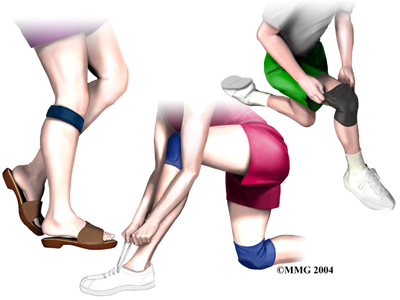 In some cases, your child may need to stop sporting activities for a short period, which allows the pain and inflammation to calm down. If the bone has completely separated then it is necessary to completely avoid sports. Fortunately it is not common that the bone completely separates, so not all athletes need to entirely avoid sports. Patients who do require a rest usually don't need to avoid sports for a long time, and often a relative rest is adequate. Taking a relative rest means decreasing the intensity or frequency of certain activities but not eliminating them completely. Your physiotherapist will advise you regarding whether or not your child needs to cease or decrease their activity. Pain that is intense enough to continue during the night, is constant, causes a limp while walking, or needs to be regularly relieved with over the counter pain medication is considered severe enough that activities need to be ceased for a defined period of time. In only very severe cases is bracing or casting recommended for periods of up to 6 weeks in order to give the chance for the pain and inflammation in the knee to calm down.
In some cases, your child may need to stop sporting activities for a short period, which allows the pain and inflammation to calm down. If the bone has completely separated then it is necessary to completely avoid sports. Fortunately it is not common that the bone completely separates, so not all athletes need to entirely avoid sports. Patients who do require a rest usually don't need to avoid sports for a long time, and often a relative rest is adequate. Taking a relative rest means decreasing the intensity or frequency of certain activities but not eliminating them completely. Your physiotherapist will advise you regarding whether or not your child needs to cease or decrease their activity. Pain that is intense enough to continue during the night, is constant, causes a limp while walking, or needs to be regularly relieved with over the counter pain medication is considered severe enough that activities need to be ceased for a defined period of time. In only very severe cases is bracing or casting recommended for periods of up to 6 weeks in order to give the chance for the pain and inflammation in the knee to calm down.
In some cases your physiotherapist may try using some tape on your child’s knee. Taping the knee or kneecap can help guide the tissues into an improved alignment, which then relieves some pressure on the painful area at the tibial tuberosity.
Orthotics, or shoe inserts, may also be suggested. The foot is the bottom of the lower extremity chain therefore putting the foot into proper alignment frequently takes pressure off of the knee, and can relief all or some of your child’s pain. Other types of braces, such as those that help to align the knee cap or add padding to the front of the knee can sometimes also be helpfulin reducing the tension and force transmitted to the tibial tubercle. Your physiotherapist at One Wellness can discuss these options with you and your child.
Once the initial pain and inflammation has calmed down, your physiotherapist will focus on improving the flexibility, strength, and alignment around the knee joint and the entire lower extremity. Static stretches to increase the flexibility of the muscles and tissues affecting the knee (particularly the quadriceps, hamstrings, hip flexors, calf, and iliotibial band on the outside of the knee) will be prescribed by your physiotherapist early on in your child’s treatment. Any tightness in the muscles or tissues around the knee can increase the pull on the patellar tendon and the tibial tuberosity, which affects alignment during walking, running or jumping. Dynamic stretching (rapid motions that stretch the tissues quickly) will also be taught and will be incorporated into your child’s rehabilitation exercise routine as part of their warm-up if they are continuing to engage in physical activity. Dynamic stretches are used to prepare the tissues for activity whereas static stretches focus more on gaining overall flexibility.
Strength imbalances will also affect the alignment of the knee and can cause muscles to tighten, which in turn may cause increased stress on the patellar tendon and tibial tuberosity. Your physiotherapist will determine which muscles in your child’s case require the most strengthening. Strength in both the knee and the hip (which controls the knee position) are very important. Increased strength and endurance can affect the ability to maintain one’s alignment, and will directly affect the amount of pressure transferred to the tibial tuberosity. Strengthening a knee that is painful can be difficult therefore it is important to follow the strict instructions of your physiotherapist regarding increasing or decreasing the load of the exercise. Overdoing an exercise can cause more harm than good in the case of Osgood Schlatter Disease. In some cases your physiotherapist may use a muscle stimulator on your child’s knee to help recruit the proper muscles around the joint.
Over time, when the knee becomes less painful your therapist will add eccentric exercises to your child’s rehabilitation routine. Eccentric contractions occur as the muscle lengthens and the tendons and their attachment points are put under stretch. For instance, when bending the knee, the quadriceps muscle, the patellar tendon, and its attachment point at the tibial tuberosity are all under load while stretching. This load is tremendous especially when deep squatting, jumping or landing from a jump. Even going down stairs puts significant load through the tissues. Eccentric exercises prepare the tissues to take these heavy types of loads. Exercises that simulate going down stairs or jumping will be prescribed. Drop squats, where your child bends their knee quickly into a squatting position and then stops rapidly, are commonly used to encourage the knee to adapt to the force that is needed to return to physical activity. Again, in dealing with pain from Osgood Schlatter Disease, any discomfort should be strictly heeded. When appropriate, weights can be added to the exercises to simulate the increased body weight that the knee endures during running and jumping. As with all the exercises, proper alignment and technique is extremely important in order to avoid flaring up the knee or creating a secondary injury. Your physiotherapist will be strict about having your child maintain good technique, and will ask you, as the parent, to also monitor this.
In addition to flexibility and strength exercises your physiotherapist will also add a proprioceptive, or balance component to your child’s rehabilitation program. With any injury or whenever pain is present, the receptors in your joints that are responsible for knowing where your body is in space decline in function. Without adequate proprioception, the muscles and joints are not used efficiently and the chance of sustaining another injury is increased. Exercises such as mini squats on a soft mat or standing on a wobbly surface are simple exercises that improve proprioception, and will also improve muscle strength and overall endurance.
All exercises given will be required to be completed not only in the clinic but also as part of a home program. Many children and adolescents can reliably do a small list of independent physiotherapy exercises, however at One Wellness we always encourage you, as the parent, to closely monitor the child’s technique and exercise frequency at home in order to get the most out of the treatment we provide.
One Wellness provides services for physiotherapy in Canmore.
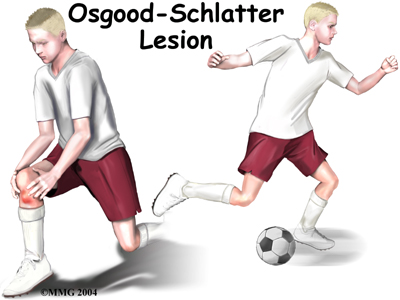 An Osgood-Schlatter lesion involves pain and swelling in the small boney bump on the front of the tibia (shinbone), right below the kneecap. It primarily occurs in children and adolescents. The problem affects the area where bone growth occurs. Too much stress on the growing bone causes the pain and swelling. The pain often worsens with activity and eases with rest. Fortunately, the condition is not serious and it is usually only temporary.
An Osgood-Schlatter lesion involves pain and swelling in the small boney bump on the front of the tibia (shinbone), right below the kneecap. It primarily occurs in children and adolescents. The problem affects the area where bone growth occurs. Too much stress on the growing bone causes the pain and swelling. The pain often worsens with activity and eases with rest. Fortunately, the condition is not serious and it is usually only temporary.
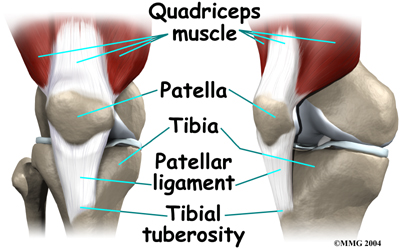
 Osgood-Schlatter lesions fit into a category of bone development disorders known as osteochondroses. (Osteo means bone, and chondro means cartilage.) In normal development, specialized bone growth centers (called growth plates) change over time from cartilage to bone. The growth centers expand and finally unite. This is how bones grow in length and width. Bone growth centers are located throughout the body.
Osgood-Schlatter lesions fit into a category of bone development disorders known as osteochondroses. (Osteo means bone, and chondro means cartilage.) In normal development, specialized bone growth centers (called growth plates) change over time from cartilage to bone. The growth centers expand and finally unite. This is how bones grow in length and width. Bone growth centers are located throughout the body.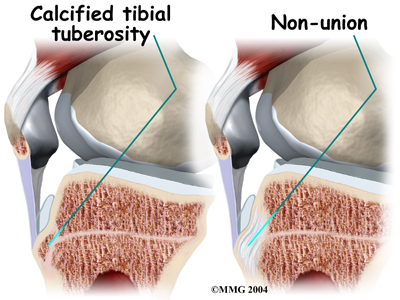 In an Osgood-Schlatter lesion, the tibial tuberosity is often enlarged and painful. It hurts when bumped. It also hurts when pressure is put on it, such as when kneeling. Activities like running, jumping, climbing, and kicking may hurt because of the tension of the patellar tendon pulling on the tibial tuberosity.
In an Osgood-Schlatter lesion, the tibial tuberosity is often enlarged and painful. It hurts when bumped. It also hurts when pressure is put on it, such as when kneeling. Activities like running, jumping, climbing, and kicking may hurt because of the tension of the patellar tendon pulling on the tibial tuberosity.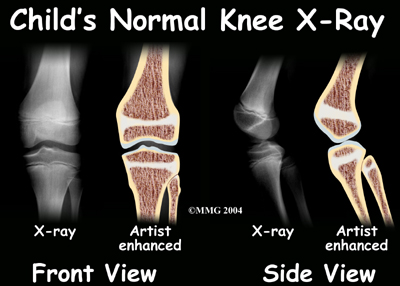 Next your physiotherapist will do a physical examination of both your child’s painful and non-painful knee, and examine the entire lower extremities for factors contributing to the problem. Your therapist will palpate, or touch, around the knee and particularly along the patellar tendon and at the tibial tuberosity to determine the exact location of pain and to note any swelling. They will assess the stability of the knee joint to determine if the laxity of the ligaments and tissues surrounding the knee joint are contributing to the problem.
Next your physiotherapist will do a physical examination of both your child’s painful and non-painful knee, and examine the entire lower extremities for factors contributing to the problem. Your therapist will palpate, or touch, around the knee and particularly along the patellar tendon and at the tibial tuberosity to determine the exact location of pain and to note any swelling. They will assess the stability of the knee joint to determine if the laxity of the ligaments and tissues surrounding the knee joint are contributing to the problem.  Your doctor may prescribe anti-inflammatory medicine to help reduce swelling.
Your doctor may prescribe anti-inflammatory medicine to help reduce swelling. In some cases, your child may need to stop sporting activities for a short period, which allows the pain and inflammation to calm down. If the bone has completely separated then it is necessary to completely avoid sports. Fortunately it is not common that the bone completely separates, so not all athletes need to entirely avoid sports. Patients who do require a rest usually don't need to avoid sports for a long time, and often a relative rest is adequate. Taking a relative rest means decreasing the intensity or frequency of certain activities but not eliminating them completely. Your physiotherapist will advise you regarding whether or not your child needs to cease or decrease their activity. Pain that is intense enough to continue during the night, is constant, causes a limp while walking, or needs to be regularly relieved with over the counter pain medication is considered severe enough that activities need to be ceased for a defined period of time. In only very severe cases is bracing or casting recommended for periods of up to 6 weeks in order to give the chance for the pain and inflammation in the knee to calm down.
In some cases, your child may need to stop sporting activities for a short period, which allows the pain and inflammation to calm down. If the bone has completely separated then it is necessary to completely avoid sports. Fortunately it is not common that the bone completely separates, so not all athletes need to entirely avoid sports. Patients who do require a rest usually don't need to avoid sports for a long time, and often a relative rest is adequate. Taking a relative rest means decreasing the intensity or frequency of certain activities but not eliminating them completely. Your physiotherapist will advise you regarding whether or not your child needs to cease or decrease their activity. Pain that is intense enough to continue during the night, is constant, causes a limp while walking, or needs to be regularly relieved with over the counter pain medication is considered severe enough that activities need to be ceased for a defined period of time. In only very severe cases is bracing or casting recommended for periods of up to 6 weeks in order to give the chance for the pain and inflammation in the knee to calm down. Surgery is not considered for an Osgood-Schlatter lesion unless bone growth is complete and symptoms are still bothersome despite nonsurgical treatments. Even under these circumstances, surgery is rarely recommended.
Surgery is not considered for an Osgood-Schlatter lesion unless bone growth is complete and symptoms are still bothersome despite nonsurgical treatments. Even under these circumstances, surgery is rarely recommended.

 (403) 679-7179
(403) 679-7179  concierge@one-wellness.ca
concierge@one-wellness.ca 

